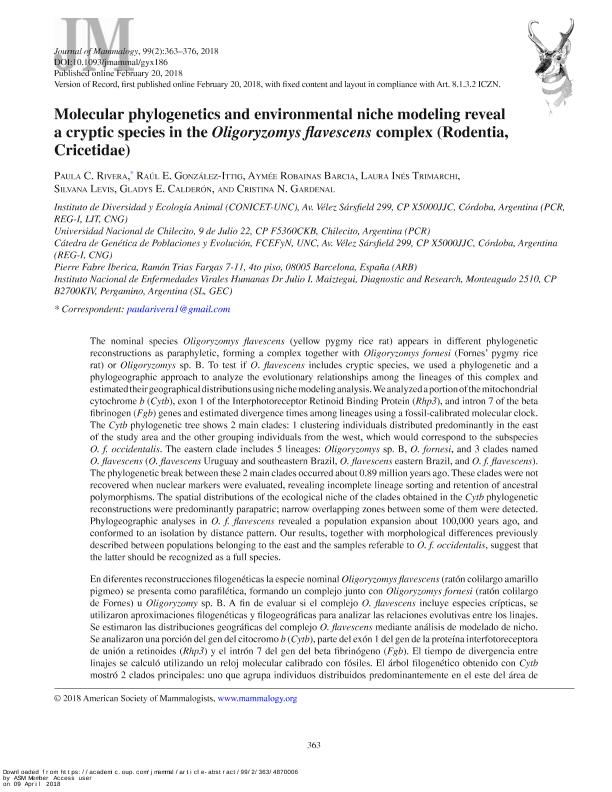Mostrar el registro sencillo del ítem
dc.contributor.author
Rivera, Paula Cecilia

dc.contributor.author
González Ittig, Raúl Enrique

dc.contributor.author
Robainas Barcia, Aymée
dc.contributor.author
Trimarchi, Laura Inés

dc.contributor.author
Levis, Silvana
dc.contributor.author
Calderon, Gladys
dc.contributor.author
Gardenal, Cristina Noemi

dc.date.available
2019-10-23T17:48:26Z
dc.date.issued
2018-04-03
dc.identifier.citation
Rivera, Paula Cecilia; González Ittig, Raúl Enrique; Robainas Barcia, Aymée; Trimarchi, Laura Inés; Levis, Silvana; et al.; Molecular phylogenetics and environmental niche modeling reveal a cryptic species in the Oligoryzomys flavescens complex (Rodentia, Cricetidae); Alliance Communications Group Division Allen Press; Journal of Mammalogy; 99; 2; 3-4-2018; 363-376
dc.identifier.issn
1545-1542
dc.identifier.uri
http://hdl.handle.net/11336/87098
dc.description.abstract
The nominal species Oligoryzomys flavescens (yellow pygmy rice rat) appears in different phylogenetic reconstructions as paraphyletic, forming a complex together with Oligoryzomys fornesi (Fornes' pygmy rice rat) or Oligoryzomys sp. B. To test if O. flavescens includes cryptic species, we used a phylogenetic and a phylogeographic approach to analyze the evolutionary relationships among the lineages of this complex and estimated their geographical distributions using niche modeling analysis. We analyzed a portion of the mitochondrial cytochrome b (Cytb), exon 1 of the Interphotoreceptor Retinoid Binding Protein (Rhp3), and intron 7 of the beta fibrinogen (Fgb) genes and estimated divergence times among lineages using a fossil-calibrated molecular clock. The Cytb phylogenetic tree shows 2 main clades: 1 clustering individuals distributed predominantly in the east of the study area and the other grouping individuals from the west, which would correspond to the subspecies O. f. occidentalis. The eastern clade includes 5 lineages: Oligoryzomys sp. B, O. fornesi, and 3 clades named O. flavescens (O. flavescens Uruguay and southeastern Brazil, O. flavescens eastern Brazil, and O. f. flavescens). The phylogenetic break between these 2 main clades occurred about 0.89 million years ago. These clades were not recovered when nuclear markers were evaluated, revealing incomplete lineage sorting and retention of ancestral polymorphisms. The spatial distributions of the ecological niche of the clades obtained in the Cytb phylogenetic reconstructions were predominantly parapatric; narrow overlapping zones between some of them were detected. Phylogeographic analyses in O. f. flavescens revealed a population expansion about 100,000 years ago, and conformed to an isolation by distance pattern. Our results, together with morphological differences previously described between populations belonging to the east and the samples referable to O. f. occidentalis, suggest that the latter should be recognized as a full species.
dc.format
application/pdf
dc.language.iso
eng
dc.publisher
Alliance Communications Group Division Allen Press

dc.rights
info:eu-repo/semantics/openAccess
dc.rights.uri
https://creativecommons.org/licenses/by-nc-sa/2.5/ar/
dc.subject
CRYPTIC SPECIES
dc.subject
NICHE MODELING
dc.subject
OLIGORYZOMYS
dc.subject
PHYLOGENY
dc.subject
PHYLOGEOGRAPHY
dc.subject
SOUTH AMERICA
dc.subject.classification
Zoología, Ornitología, Entomología, Etología

dc.subject.classification
Ciencias Biológicas

dc.subject.classification
CIENCIAS NATURALES Y EXACTAS

dc.title
Molecular phylogenetics and environmental niche modeling reveal a cryptic species in the Oligoryzomys flavescens complex (Rodentia, Cricetidae)
dc.type
info:eu-repo/semantics/article
dc.type
info:ar-repo/semantics/artículo
dc.type
info:eu-repo/semantics/publishedVersion
dc.date.updated
2019-10-16T14:30:54Z
dc.identifier.eissn
0022-2372
dc.journal.volume
99
dc.journal.number
2
dc.journal.pagination
363-376
dc.journal.pais
Estados Unidos

dc.journal.ciudad
Lawrence
dc.description.fil
Fil: Rivera, Paula Cecilia. Consejo Nacional de Investigaciones Científicas y Técnicas. Centro Científico Tecnológico Conicet - Córdoba. Instituto de Diversidad y Ecología Animal. Universidad Nacional de Córdoba. Facultad de Ciencias Exactas Físicas y Naturales. Instituto de Diversidad y Ecología Animal; Argentina
dc.description.fil
Fil: González Ittig, Raúl Enrique. Consejo Nacional de Investigaciones Científicas y Técnicas. Centro Científico Tecnológico Conicet - Córdoba. Instituto de Diversidad y Ecología Animal. Universidad Nacional de Córdoba. Facultad de Ciencias Exactas Físicas y Naturales. Instituto de Diversidad y Ecología Animal; Argentina
dc.description.fil
Fil: Robainas Barcia, Aymée. Pierre Fabre Iberica; España
dc.description.fil
Fil: Trimarchi, Laura Inés. Consejo Nacional de Investigaciones Científicas y Técnicas. Centro Científico Tecnológico Conicet - Córdoba. Instituto de Diversidad y Ecología Animal. Universidad Nacional de Córdoba. Facultad de Ciencias Exactas Físicas y Naturales. Instituto de Diversidad y Ecología Animal; Argentina
dc.description.fil
Fil: Levis, Silvana. Instituto Nacional de Enfermedades Virales Humanas Dr Julio I. Maiztegui; Argentina
dc.description.fil
Fil: Calderon, Gladys. Instituto Nacional de Enfermedades Virales Humanas Dr Julio I. Maiztegui; Argentina
dc.description.fil
Fil: Gardenal, Cristina Noemi. Consejo Nacional de Investigaciones Científicas y Técnicas. Centro Científico Tecnológico Conicet - Córdoba. Instituto de Diversidad y Ecología Animal. Universidad Nacional de Córdoba. Facultad de Ciencias Exactas Físicas y Naturales. Instituto de Diversidad y Ecología Animal; Argentina
dc.journal.title
Journal of Mammalogy

dc.relation.alternativeid
info:eu-repo/semantics/altIdentifier/doi/http://dx.doi.org/10.1093/jmammal/gyx186
dc.relation.alternativeid
info:eu-repo/semantics/altIdentifier/url/https://academic.oup.com/jmammal/article/99/2/363/4870006
Archivos asociados
